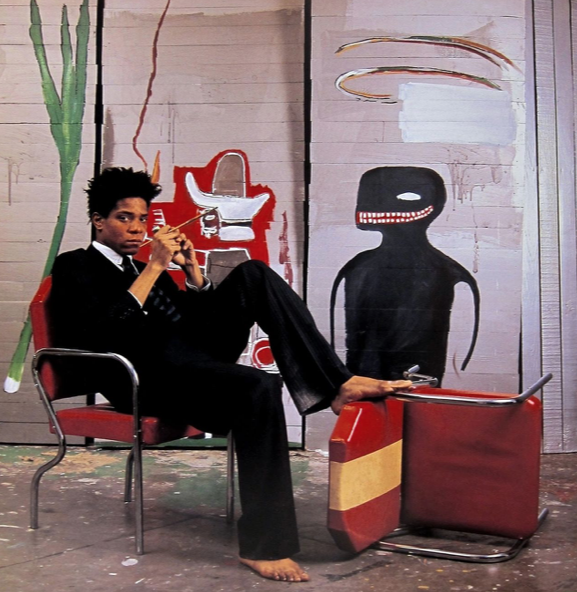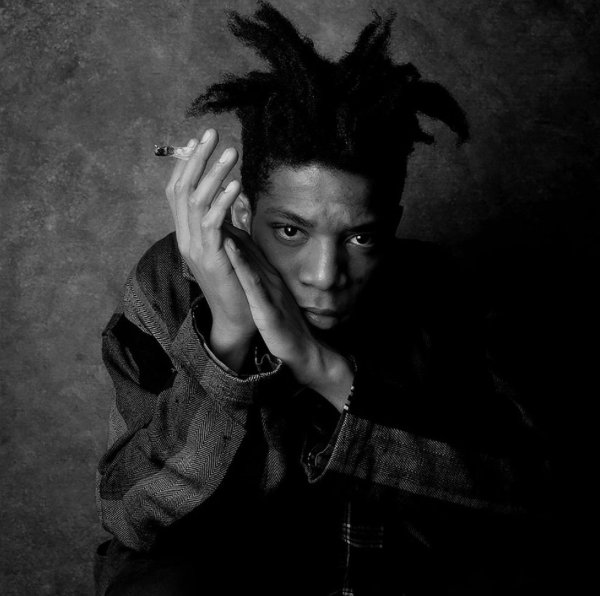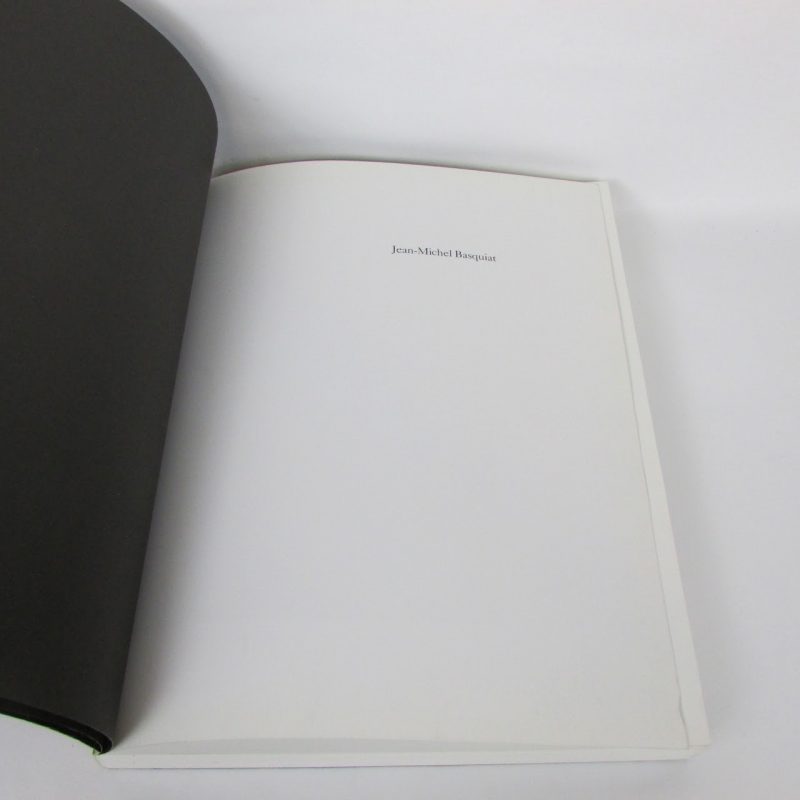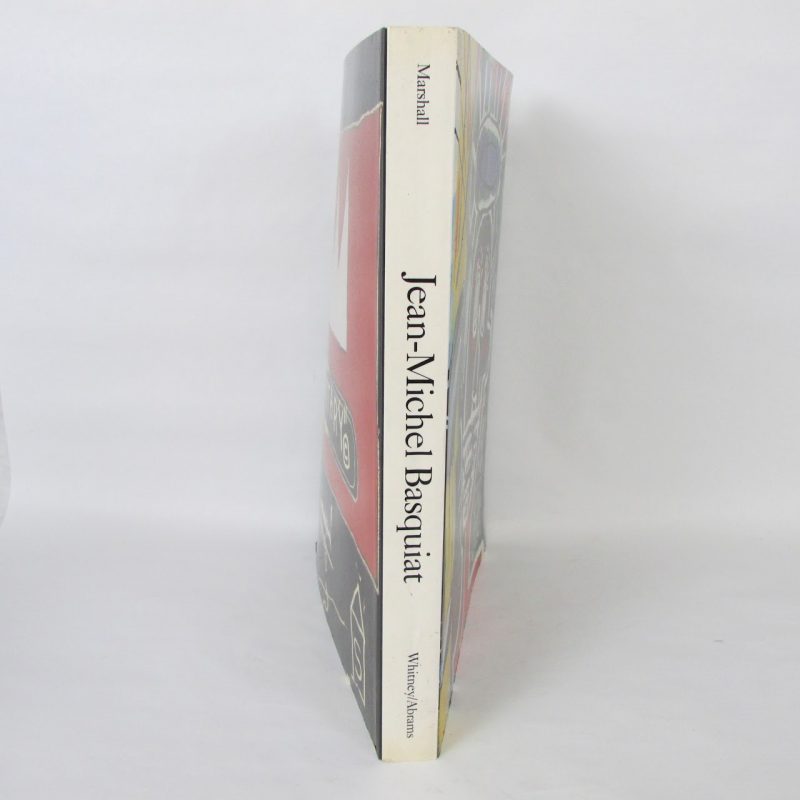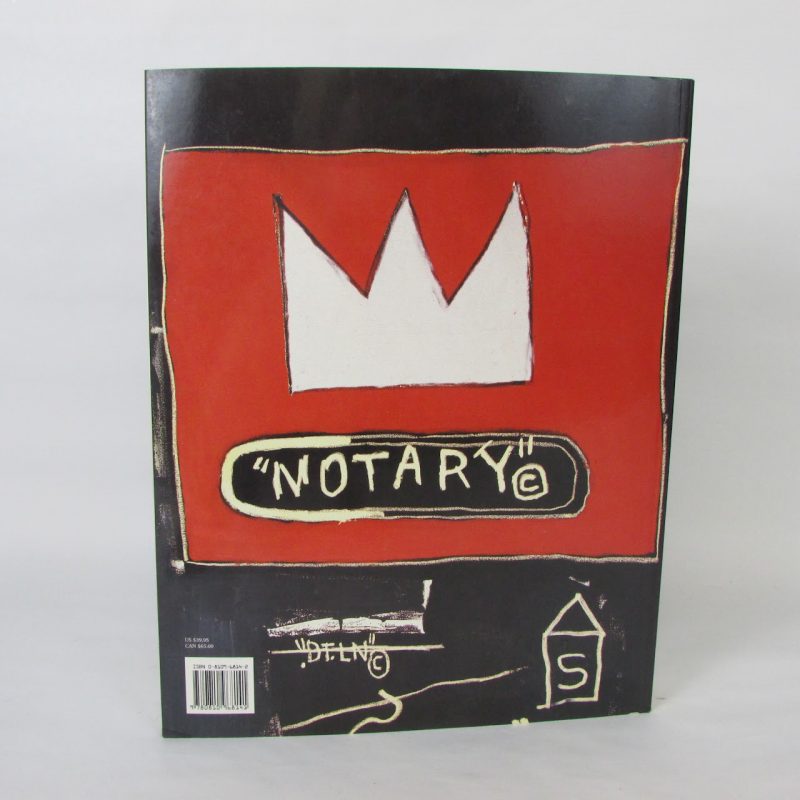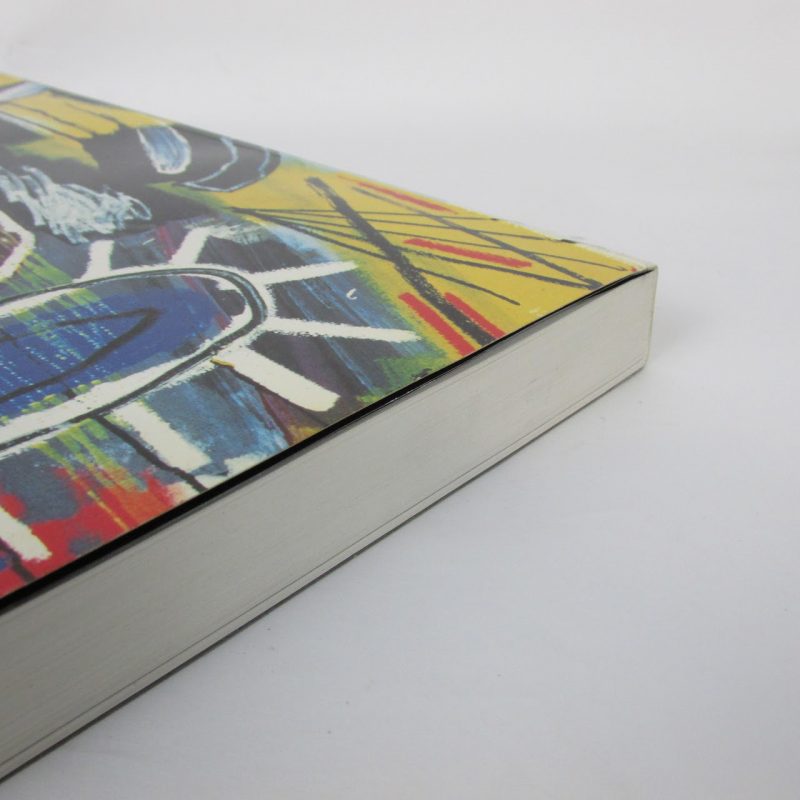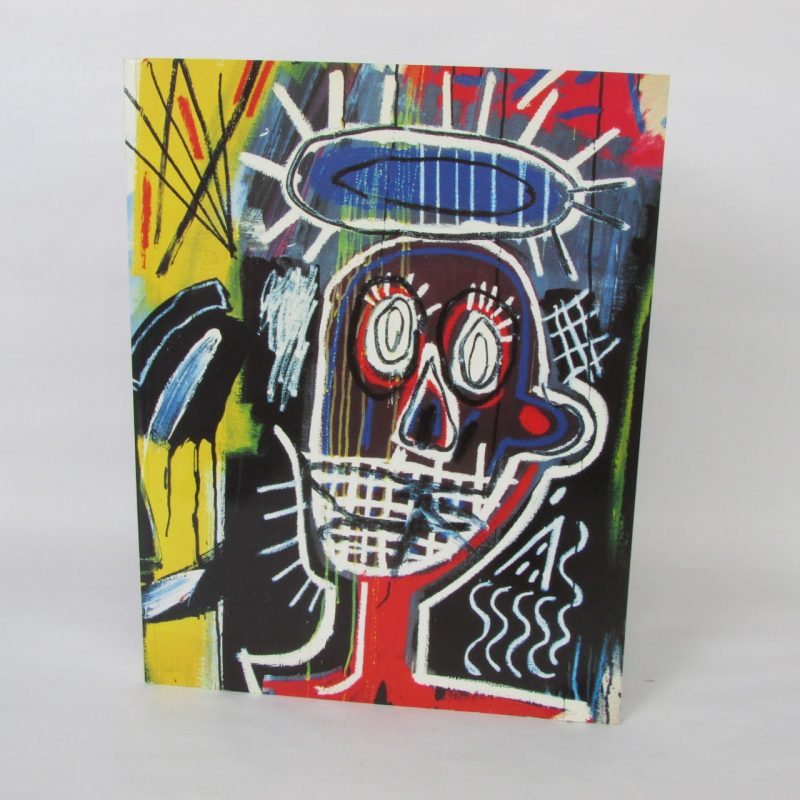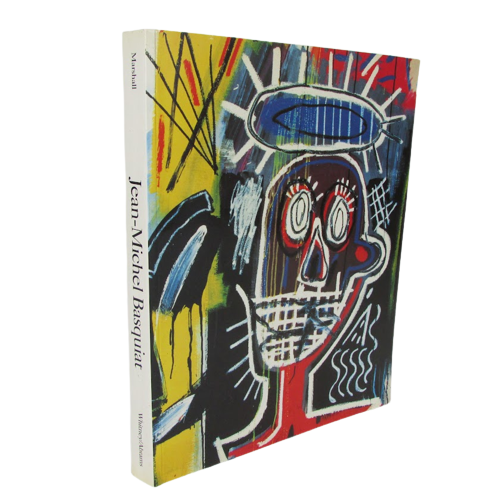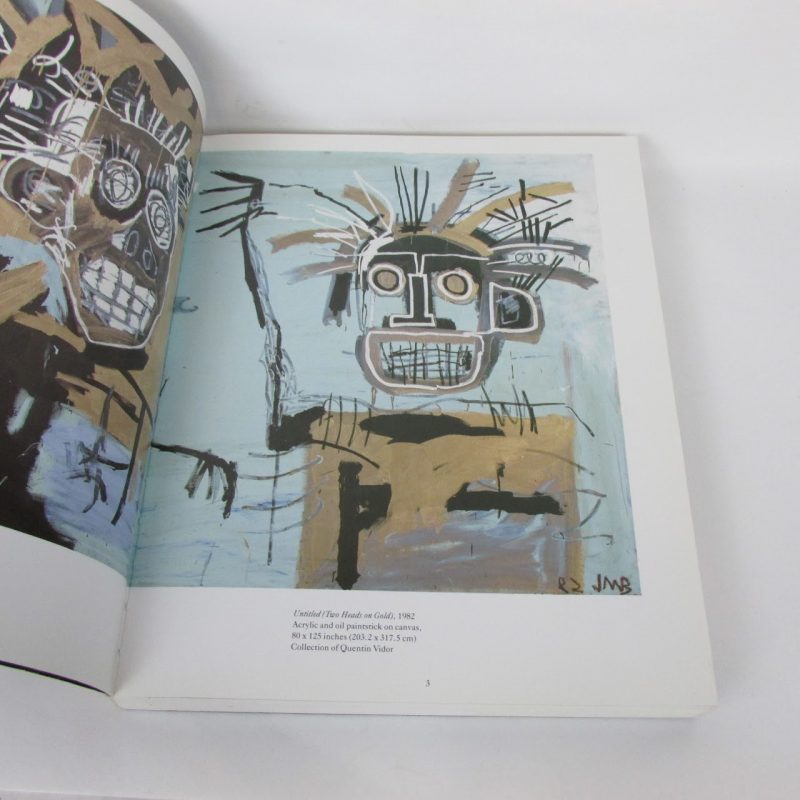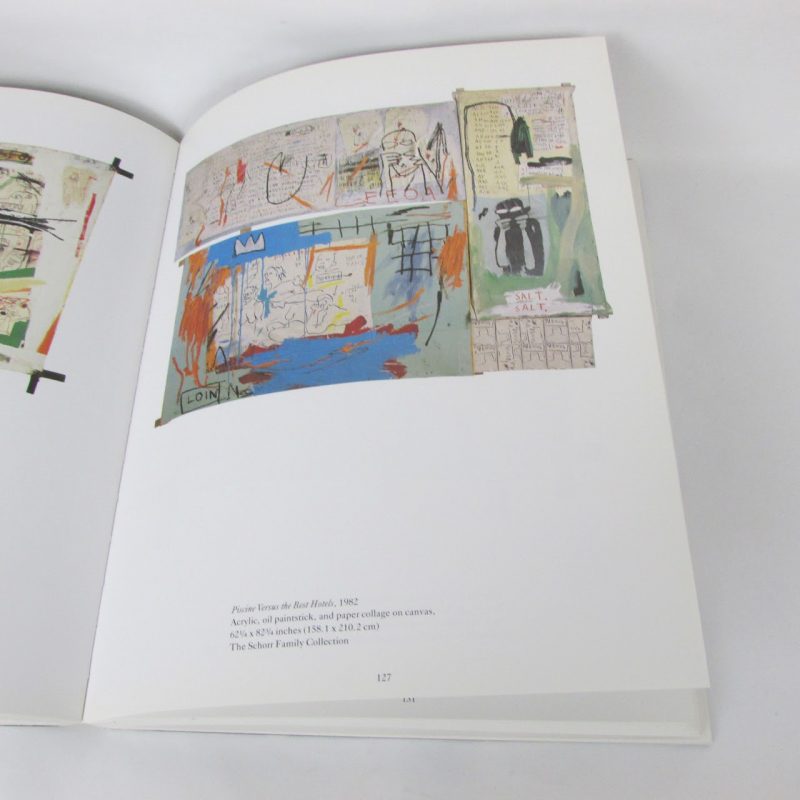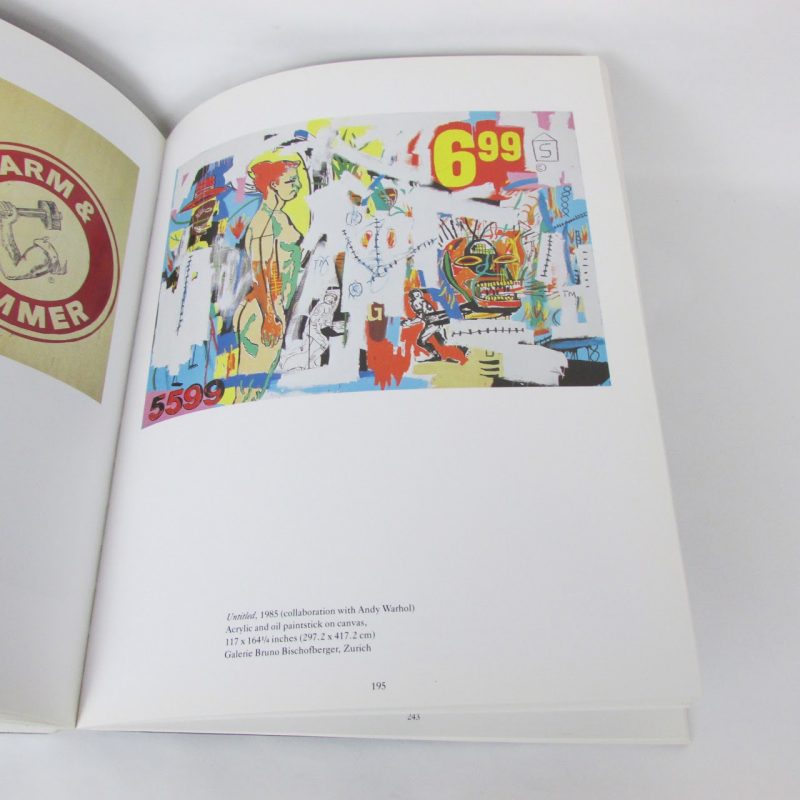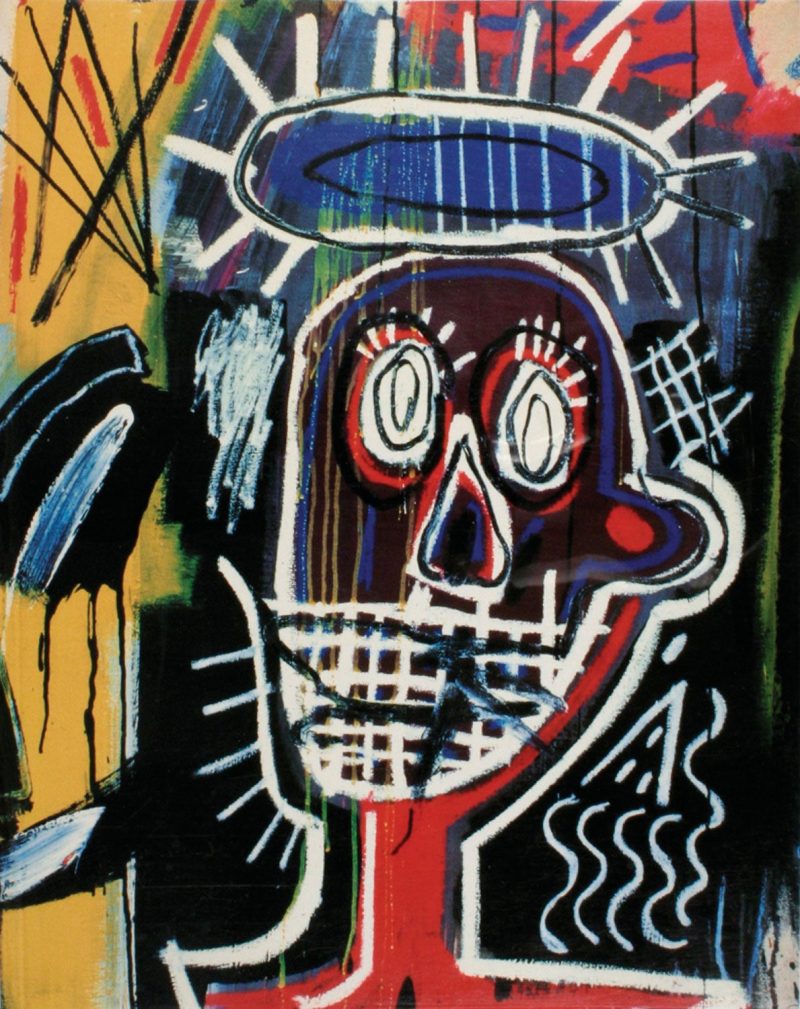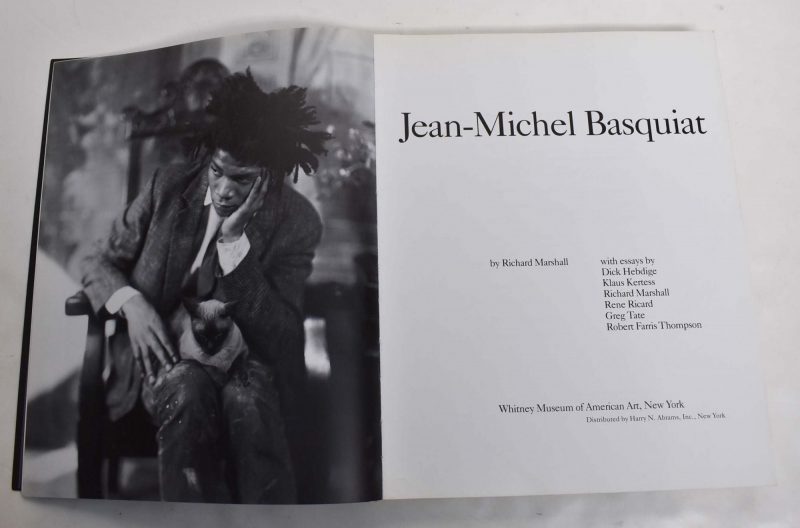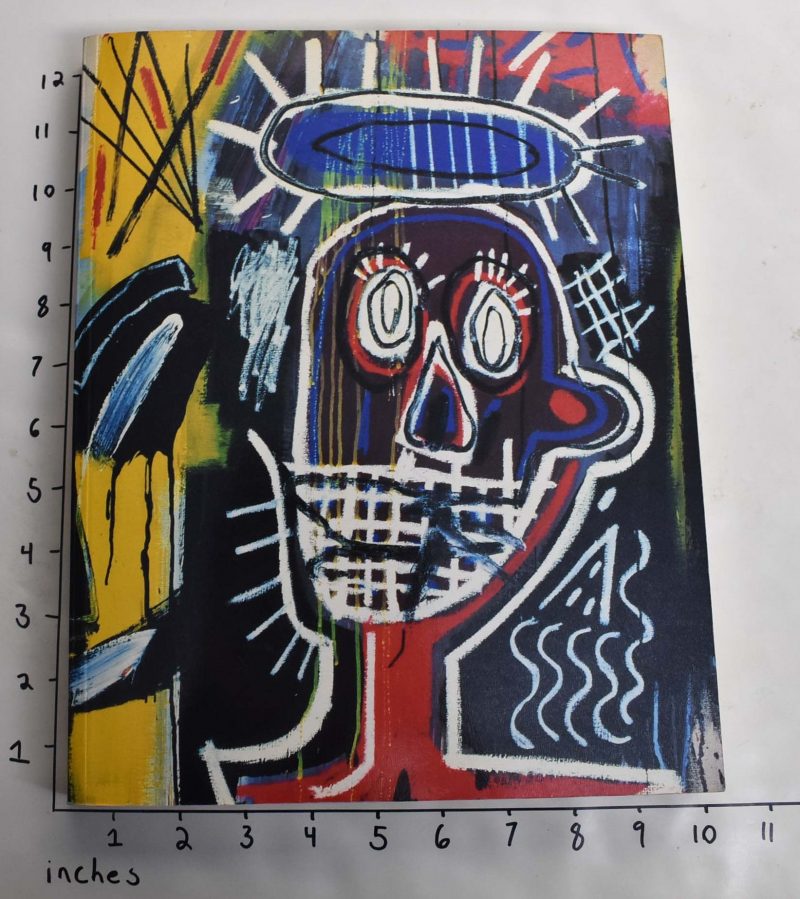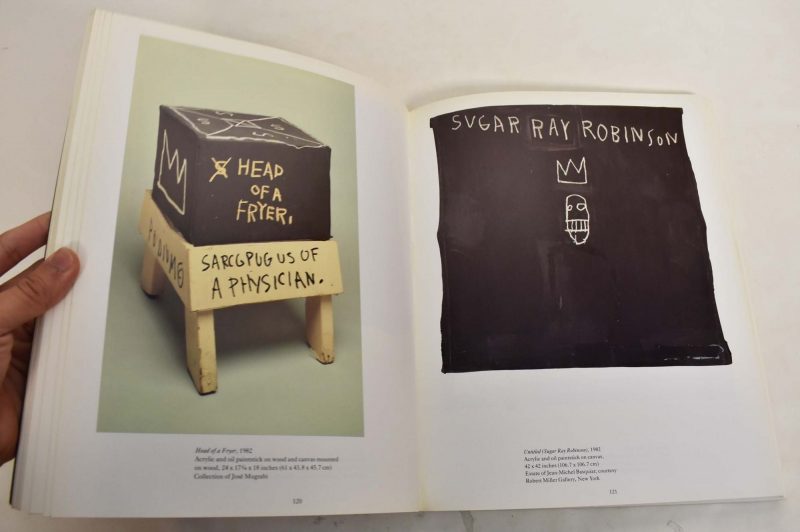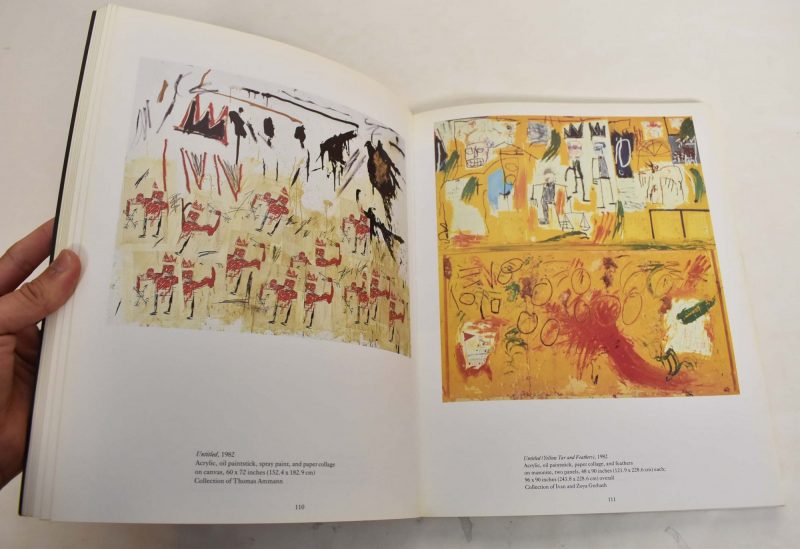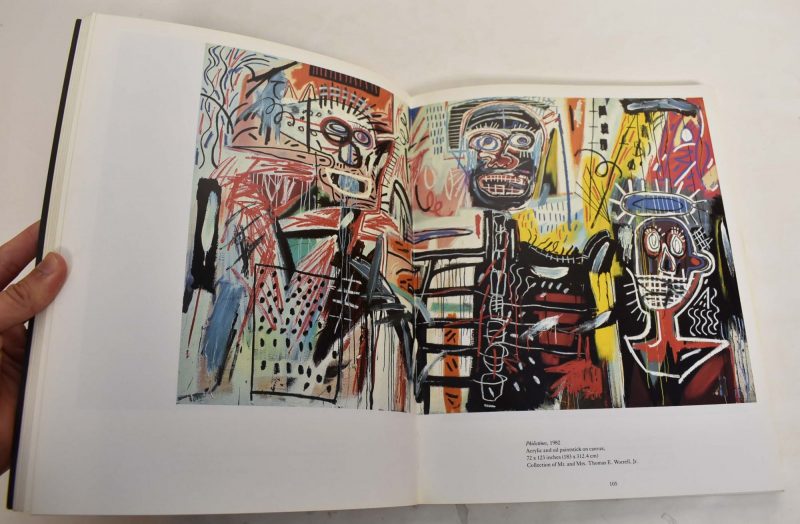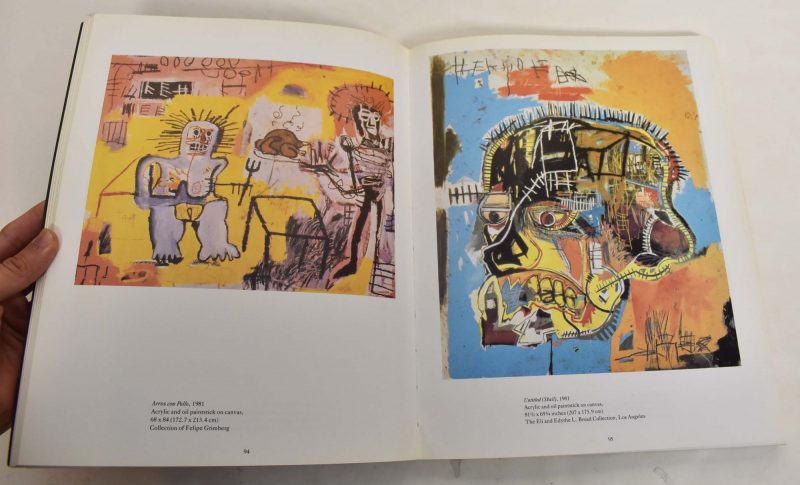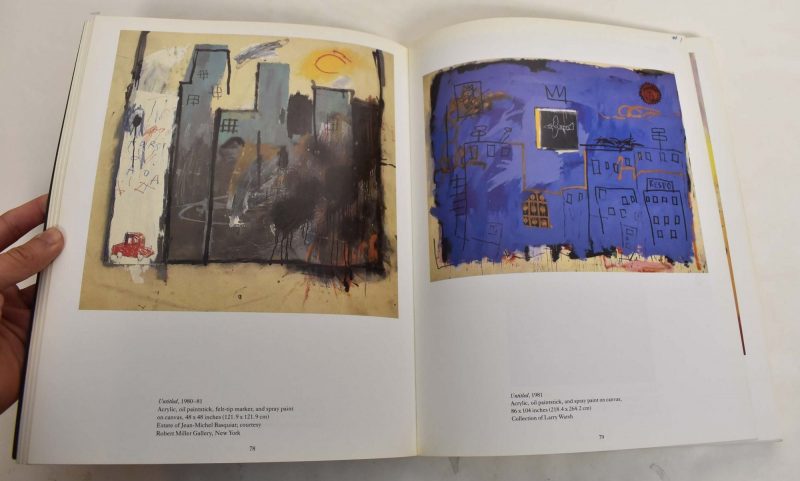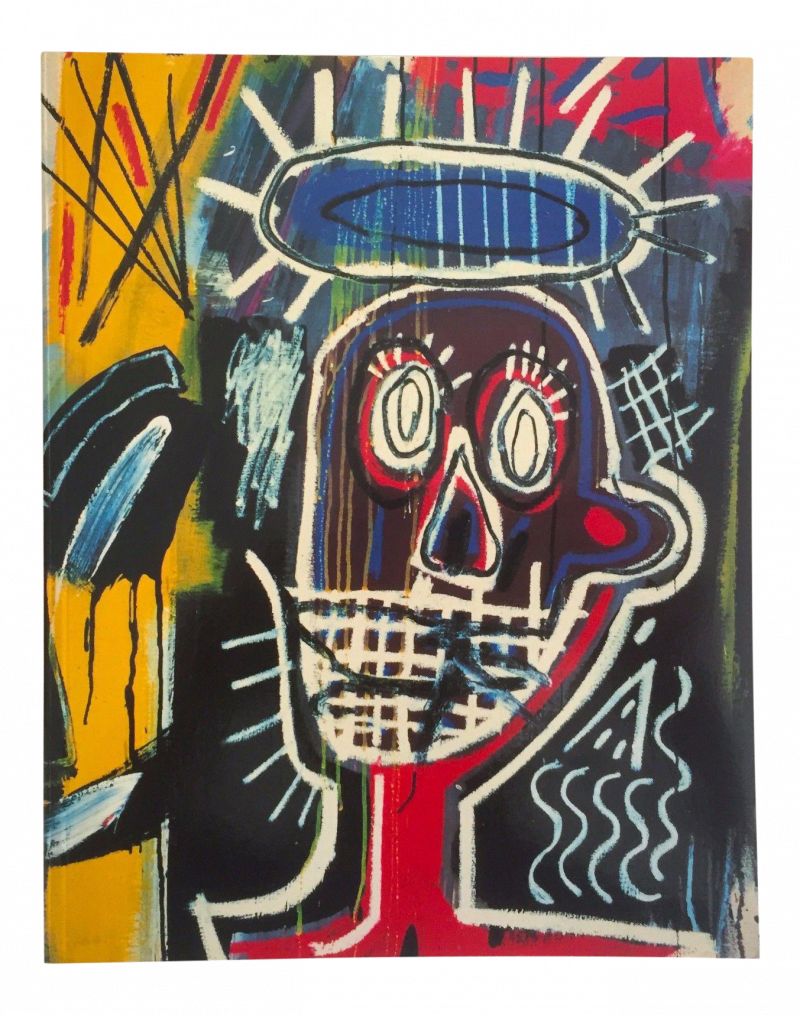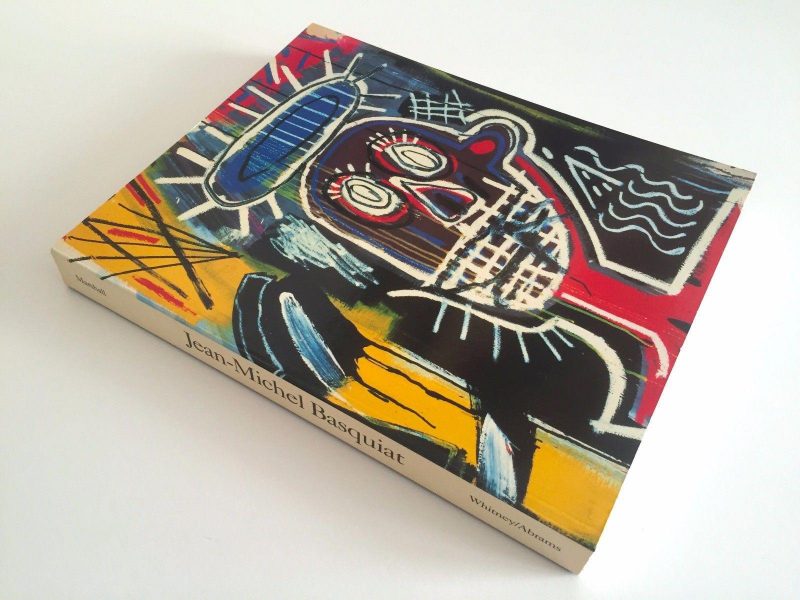SOLD. JEAN-MICHEL BASQUIAT @ Whitney Museum of Art, New York, 1992
Marshall, Richard et al. JEAN-MICHEL BASQUIAT. 272 pp., with 200 illustrations, including 160 in full color. 4to, wraps. New York, Whitney Museum of Art and New York, Abrams, 1992.
Exhibititon Locations:
Jean-Michel Basquiat: Whitney Museum of American Art, New York October 23, 1992 – February 14, 1993
The Menil Collection, Houston March 11 – May 9, 1993
Des Moines Art Center, Iowa May 22 – August 15, 1993
Montgomery Museum of Fine Arts, Alabama November 18, 1993 – January 9, 1994
Accompanying the Whitney Museum’s retrospective, this is the most complete publication to date on Basquiat, giving a complete overview of the artist’s work in all formats, and much biographical detail through seven separate essays.
This is a survey of the work of Jean-Michel Basquiat (1960-1988), a key member of a group of New York artists who used the powerful images of graffiti to create a new expressive language. Published to accompany an exhibition held at the Whitney Museum of American Art, New York, in 1992-93, the book contains illustrations reproducing paintings, drawings, collages, silkscreens, and constructions, many previously unpublished.
Appraised at $225.00
Offered at USD$150.
SOLD.
Jean Michel Basquiat
In the 1980s, as a member of the Neo-expressionist movement, American artist Jean-Michel Basquiat(December 22, 1960 – August 12, 1988) achieved success.
As a member of the graffiti duo SAMO with Al Diaz in the late 1970s, when rap, punk, and street art came together to form the early hip-hop music scene, Basquiat first rose to recognition by creating enigmatic epigrams. His works were on display in galleries and museums all over the world by the start of the 1980s. At age 21, Basquiat made history by participating in Documenta in Kassel, Germany, as the youngest artist ever. He was one of the youngest artists to display at the Whitney Biennial in New York at the age of 22. In 1992, his works were featured in a retrospective at the Whitney Museum of American Art.
The dichotomies of wealth against poverty, integration versus segregation, and inner versus exterior experience were major themes in Basquiat’s work. He combined text and picture, abstraction and figuration, historical details and modern critique, and he appropriated poetry, drawing, and painting. In addition to criticizing racial injustice and power structures, he employed social commentary in his paintings as a means of self-examination and identification with the experiences he had growing up in the black community. His visual poetry was sharply political, blunt in its opposition to colonialism, and supportive of the working class.
When Basquiat passed away in 1988 at the age of 27, the worth of his artwork has risen steadily. One of the most expensive paintings ever acquired, Untitled, a 1982 picture of a black skull with red and yellow rivulets, sold for a record-breaking $110.5 million in 2017.
Basquiat was the second of Matilde Basquiat’s four children (née Andrades, 1934–2008) and Gérard Basquiat’s four children when he was born on December 22, 1960, in Park Slope, Brooklyn, New York City (1930–2013). He had two younger sisters, Lisane (b. 1964) and Jeanine, as well as an elder brother, Max, who passed away just before he was born (b. 1967). His mother was born in Brooklyn to Puerto Rican parents, while his father was born in Port-au-Prince, Haiti. His upbringing was Catholic.
By bringing her young son to nearby museums and enrolling him as a junior member of the Brooklyn Museum of Art, Matilde nurtured a love of art in him. Basquiat was a bright youngster who could read and write by the time he was four. His mother praised his artistic ability, and he frequently tried to recreate his favorite cartoons. He began going to the elite Saint Ann’s School in 1967. There, he ran across his buddy Marc Prozzo, and the two collaborated to write and illustrate a children’s book, which was written by Basquiat when he was seven years old.
At the age of seven, Basquiat was struck by a car in 1968 as he played on the street. He had many internal injuries that necessitated a splenectomy, along with a shattered arm. His mother gave him a copy of Gray’s Anatomy to keep him entertained while he was in the hospital. Basquiat and his sisters were reared by their father when his parents divorced in that same year. When he was ten years old, his mother was admitted to a mental hospital, and she spent the rest of her life in and out of institutions. Basquiat was a voracious reader and a trilingual speaker by the time he was eleven years old.
The family of Basquiat first lived in the Boerum Hill area of Brooklyn before relocating to Miramar, Puerto Rico, in 1974. In 1976, when they moved back to Brooklyn, Basquiat enrolled at Edward R. Murrow High School. As a teenager, he struggled to cope with his mother’s instability and rebelled. When he was 15, his father saw him smoking marijuana in his room, and he fled the house. He consumed acid while dozing off on park seats in Washington Square Park. The cops were summoned to bring him home after his father eventually noticed him with a shorn head.
He enrolled at City-As-School at Manhattan’s alternative high school for kids who struggled in traditional education while they were in the tenth grade. He would skip class with his pals, but his teachers would still encourage him, and he started to write and draw for the school newspaper. In order to promote a fake religion, he created the character SAMO. As an acronym for the expression “Same old shit,” “SAMO” first emerged as a private joke between Basquiat and his classmate Al Diaz. Before and after using SAMO, they created a series of cartoons for their school newspaper.
Basquiat and Diaz started spray painting graffiti on Lower Manhattan buildings in May 1978. Operating under the alias SAMO, they penned humorous and poetic commercial slogans like “SAMO AS AN ALTERNATIVE TO GOD.” Basquiat was expelled from City-As-School in June 1978 after punching the principal. When he chose to stop attending school at age 17, his father ejected him from the house. He continued to make graffiti at night while working at the Unique Clothes Warehouse in NoHo. The Village Voice published a piece about the SAMO graffiti on December 11, 1978.
Basquiat made an appearance on Glenn O’Brien’s live public access television program TV Party in 1979. Basquiat and O’Brien became friends, and during the following few years, he frequently appeared on the program. [34] He eventually started spending time around the School of Visual Arts creating graffiti, where he became friends with classmates John Sex, Kenny Scharf, and Keith Haring.
At the Canal Zone Party in April 1979, Basquiat and Michael Holman started the noise rock group Test Pattern, subsequently became Gray. Shannon Dawson, Nick Taylor, Wayne Clifford, and Vincent Gallo were more Gray members. In nightclubs including Max’s Kansas City, CBGB, Hurrah, and the Mudd Club, they gave performances.
Basquiat and his friend Alexis Adler, a recent Barnard biology graduate, were residing in the East Village at this time. He frequently reproduced chemical compound representations from Adler’s science texts. She captured Basquiat’s artistic excursions as he turned the furniture, doors, walls, and floors into his works of art. Along with his friend Jennifer Stein, he also created postcards. Basquiat saw Andy Warhol and art critic Henry Geldzahler at W.P.A. restaurant while he was hawking postcards in SoHo. He offered Dumb Games, Poor Ideas, a postcard for sale to Warhol.
In October 1979, Basquiat displayed his SAMO montages utilizing color Xerox copies of his artwork at Arleen Schloss’s open space known as A’s.
Basquiat was able to use the location to produce his painted upcycled clothing known as “MAN MADE” thanks to Schloss. Costume designer Patricia Field carried his clothes collection in her posh East Village store on 8th Street in November 1979. In the shop window, Field also had his sculptures on display.
In 1980, after a fight with Diaz, Basquiat wrote “SAMO IS DEAD” on the walls of SoHo structures. He made his first appearance in a national magazine, High Times, in June 1980. Glenn O’Brien wrote a piece titled “Graffiti ’80: The Status of the Outlaw Art” that featured him. Later that year, he started shooting O’Brien’s independent movie Downtown 81 (2000), which was first called New York Beat and had some of Gray’s tracks on its soundtrack.
In June 1980, Collaboration Projects Incorporated (Colab) and Fashion Moda sponsored the multi-artist event The Times Square Show, in which Basquiat took part. Jeffrey Deitch, who wrote about him in an article titled “Report from Times Square” in the September 1980 issue of Art in America, was one critic and curator who took note of him. Basquiat took part in the Diego Cortez-curated New York/New Wave exhibition in February 1981 at New York’s P.S. 1. Italian dealer Emilio Mazzoli was introduced to Basquiat’s work by Italian artist Sandro Chia, who instantly purchased 10 of the artist’s works so that Basquiat could have a display at his gallery in Modena, Italy, in May 1981. The first in-depth essay about Basquiat was “The Radiant Kid,” written by art critic Rene Ricard and published in Artforum magazine in December 1981. During this time, Basquiat painted numerous works on items he discovered in the streets, such abandoned doors.
Following their collaboration on the Downtown 81 film, Debbie Harry, the lead singer of the punk rock band Blondie, purchased Cadillac Moon (1981), Basquiat’s debut painting, for $200. In the 1981 Blondie song video “Rapture,” he also played a disc jockey, a role that was initially written for Grandmaster Flash. During the time, Basquiat shared a residence with his lover Suzanne Mallouk, who worked as a waitress to support him financially.
On the advice of Sandro Chia, art dealer Annina Nosei encouraged Basquiat to join her gallery in September 1981. He took part in her group exhibition Public Speaking not long after that. She gave him supplies and a place to work in the gallery’s basement. Nosei made arrangements for him to relocate to a loft that doubled as a studio at 101 Crosby Street in SoHo in 1982. In March 1982, he held his first US solo exhibition at the Annina Nosei Gallery. At his second Italian exhibition in March 1982, he also painted in Modena. That show was canceled because he was required to produce eight paintings in a single week, and he felt abused.
During the summer of 1982, Basquiat had departed the Annina Nosei Gallery, and Bruno Bischofberger, a gallerist, had taken over as his representative internationally. At age 21, Basquiat was the youngest artist to ever participate at Documenta in Kassel, Germany, in June 1982. His works were displayed alongside those of Andy Warhol, Gerhard Richter, Cy Twombly, Joseph Beuys, and Anselm Kiefer. In September 1982, Bischofberger hosted a solo exhibition of Basquiat’s work in his Zurich gallery, and on October 4, 1982, he set up a lunch meeting between Basquiat and Warhol. According to Warhol, “I snapped a Polaroid, he went home, and within two hours a painting of him and I together was returned, still wet.” Dos Cabezas (1982), an artwork, sparked their friendship. James Van Der Zee took a photo of Basquiat for a Henry Geldzahler interview that appeared in Warhol’s Interview magazine’s January 1983 issue.
The Fun Gallery in the East Village hosted Basquiat’s solo exhibition, which debuted in November 1982. The pieces on display included Equals Pi and A Panel of Experts, both from 1982. (1982). Basquiat started working in the studio facility that art dealer Larry Gagosian had constructed beneath his Venice, California house in early December 1982. He started a series of paintings there for a March 1983 exhibition, his second at the West Hollywood Gagosian Gallery. His lover, the at-the-time unknown singer Madonna, was with him. According to Gagosian, “Everything was operating smoothly. We were having a great time while I was selling Jean-paintings Michel’s and he was creating his own. Jean-Michel eventually said, “My girlfriend is coming to reside with me,” though. So I asked, “So, how is she?” “Her name is Madonna, and she’s going to be huge,” he continued. He mentioned something that I’ll never forget.”
The artwork that Robert Rauschenberg was creating at Gemini G.E.L. in West Hollywood piqued Basquiat’s interest. He visited him frequently and took encouragement from his achievements. While living in Los Angeles, Basquiat created the painting Hollywood Africans (1983), which features him alongside the graffiti artists Rammellzee and Toxic. With pieces like Portrait of A-One A.K.A. King (1982), Toxic (1984), and ERO, he frequently created portraits of other graffiti artists, sometimes working in collaboration with them (1984). He created the hip-hop song “Beat Bop” in 1983, which featured Rammellzee and rapper K-Rob. It was only printed in a small number of copies under his Tartown Inc. imprint. The single’s cover art was designed by him, making it very popular with both record and art collectors.
At the age of 22, Basquiat was one of the youngest artists to take part in the Whitney Biennial exhibition of modern art in March 1983. In April 1983, Paige Powell, an associate publisher for Interview magazine, hosted a display of his artwork in the residence of a friend in New York. Soon after, he started dating Powell, who was important in helping him develop his bond with Warhol. At 57 Great Jones Street in NoHo, a Warhol-owned loft that also acted as a studio, Basquiat moved in in August 1983.
Basquiat invited Lee Jaffe, a former member of Bob Marley’s band, to travel with him through Asia and Europe in the summer of 1983. Michael Stewart, a budding black artist in the downtown club scene who was assassinated by transit police in September 1983, left a profound impression on him upon his return to New York. In response to the event, he created Defacement (The Death of Michael Stewart) (1983). In 1983, he additionally took part in a Christmas fundraiser for the Stewart family with a number of other New York artists.
Basquiat had his first exhibition at Mary Boone’s SoHo gallery in May 1984 after joining in 1983. Several images show Warhol and Basquiat working together in the years 1984 and 1985. When they worked together, Warhol would begin with a very precise idea or recognized image, which Basquiat would later deface in his lively manner. Olympics was their homage to the 1984 Summer Olympics (1984). Other partnerships exist, such as Taxi, 45th/Broadway (1984–85), and Zenith (1985). After their joint exhibition, Paintings, at the Tony Shafrazi Gallery was slammed by critics and Basquiat was referred to as Warhol’s mascot, their friendship soured.
Basquiat frequently painted in pricey Armani outfits and would show up in public wearing the same garments covered in paint. He frequently frequented the Area nightclub, where he occasionally performed as a DJ for amusement. Moreover, he created murals for New York City’s Palladium nightclub. In the media, his quick ascent to stardom was documented. He was featured in the article “New Art, New Money: The Marketing of an American Artist” that was on the cover of The New York Times Magazine’s issue from February 10, 1985. He was interviewed for MTV’s “Art Break” segment, and his art has been featured in GQ and Esquire. He appeared on the Comme des Garçons Spring runway in New York in 1985.
Midway through the 1980s, Basquiat was making $1.4 million a year and getting one-time payments from art dealers of $40,000. His emotional instability followed him despite his accomplishments. Basquiat’s drug use and paranoia increased as his wealth increased, according to journalist Michael Shnayerson. Because of his severe cocaine use, Basquiat ruptured his nasal septum. According to a friend, late in 1980, Basquiat admitted to using heroin. Many of his contemporaries theorized that he turned to drugs as a way to deal with the pressures of his newfound popularity, the exploitative nature of the art business, and the pressures of being a black man in a white-dominated field.
In January 1986, Basquiat traveled back to Los Angeles for his exhibition at the Gagosian Gallery, which would be his final on the West Coast.
Basquiat came to Atlanta, Georgia, in February 1986 for a drawing exhibition at the Fay Gold Gallery.
He took part in the Limelight organization’s Art Against Apartheid fundraiser that month. In the summer, he held a one-man show at Salzburg’s Galerie Thaddaeus Ropac. Moreover, he was given the opportunity to walk the runway once more for Rei Kawakubo, at the Comme des Garçons Homme Plus fashion show in Paris. Bruno Bischofberger organized a Basquiat exhibition at the French Cultural Institute in Abidjan in October 1986, so the artist took a plane there. He was joined by his girlfriend Jennifer Goode, who worked at Area nightclub, which he frequently frequented. In November 1986, when he was 25 years old, Basquiat made history by becoming the youngest artist to have a show at Hanover, Germany’s Kestner-Gesellschaft.
Since she had access to drugs during their relationship, Goode started sniffing heroin with Basquiat. She claimed, “He didn’t force it on me, but it was just there and I was so naive. She was successful in enrolling Basquiat and herself in a methadone program in Manhattan toward the end of 1986, but he left after three weeks. Goode claims that he didn’t begin injecting heroin prior to her ending their relationship. Basquiat had a bit of a reclusive personality in the last 18 months of his life. It is believed that his continuing drug usage was a coping mechanism for him following the death of his friend Andy Warhol in February 1987.
Basquiat held shows in 1987 at the Tony Shafrazi Gallery in New York, the Akira Ikeda Gallery in Tokyo, and Galerie Daniel Templon in Paris. For André Heller’s Luna Luna, a transient amusement park in Hamburg that operated from June to August 1987 and featured rides created by well-known modern artists, he created a Ferris wheel.
Basquiat made trips to Düsseldorf and Paris in January 1988 in preparation for his exhibitions at the Hans Mayer Gallery and the Yvon Lambert Gallery, respectively. He made friends with Ivorian artist Ouattara Watts while he was in Paris. They agreed to take a trip to Korhogo, where Watts was born, that summer. After having a show in April 1988 at the Vrej Baghoomian Gallery in New York, Basquiat went to Maui in June to stop using drugs. In July, after arriving back in New York, Basquiat ran into Keith Haring on Broadway. According to Haring, this was the only time they had ever spoken about Basquiat’s drug use. Glenn O’Brien said that Basquiat had contacted him and expressed how “wonderful” he was feeling.
Despite his attempts at recovery, Basquiat passed away from a heroin overdose on August 12, 1988, at the age of 27, in his Manhattan residence on Great Jones Street. His fiancée Kelle Inman had discovered him unconscious in his bedroom and brought him to Cabrini Medical Center, where he was already dead when they got there.
Green-Wood Cemetery in Brooklyn is where Basquiat is laid to rest. On August 17, 1988, a private funeral was performed at Frank E. Campbell Funeral Home. Family members and close acquaintances, including Keith Haring, Francesco Clemente, Glenn O’Brien, and Basquiat’s ex-girlfriend Paige Powell, attended the funeral. Jeffrey Deitch, an art dealer, gave a eulogy.
On November 3, 1988, Saint Peter’s Church had a public memorial. Ingrid Sischy, the editor of Artforum, who got to know Basquiat well and commissioned several articles introducing his work to the general public, was one of the presenters. Suzanne Mallouk, Basquiat’s ex-girlfriend, delivered passages from A. R. Penck’s “Poem for Basquiat,” while Fab 5 Freddy, a friend of the artist, read a poem by Langston Hughes. Glenn O’Brien, Keith Haring, David Shapiro, Glenn O’Brien, and members of Basquiat’s old band Gray were among the 300 attendees.
Keith Haring painted A Pile of Crowns for Jean-Michel Basquiat as a tribute to the late artist. Haring said the following in the obituary he wrote for Vogue: “In just ten years, he produced a lifetime’s worth of art. Greedily, we speculate about what other works he may have produced and what masterpieces his passing has denied us access to, but the truth is that he has left behind a body of work that will continue to fascinate future generations. Just now are people starting to realize how significant his contribution was “.
Franklin Sirmans, an art critic, said that Basquiat appropriated poetry, drawing, and painting and combined text and image, abstraction, figuration, and historical data with modern criticism. His social critique was sharply political, blunt, and supportive of class struggle and colonialism. He also looked into a variety of artistic traditions, including the Classical tradition. Basquiat’s self-identification as an artist, according to art historian Fred Hoffman, may have been rooted in his “innate capacity to function as something akin to an oracle, distilling his perceptions of the outside world down to their essence and, in turn, projecting them outward through his creative act,” and his work centered on recurrent “suggestive dichotomies” like wealth versus poverty, integration versus segregation, and inner versus outer experience.
Before starting his career as a painter, Basquiat created punk-inspired postcards to sell on the street and rose to fame as SAMO for his political and poetic graffiti. He frequently drew on unexpected surfaces and items, including other people’s clothes. His art incorporates a variety of media in unique ways. His works frequently feature many sorts of codes, including words, characters, numbers, pictograms, logos, map symbols, and diagrams.
Texts were mostly used by Basquiat as reference material. Among the books he used were Burchard Brentjes’ African Rock Art, Flash of the Spirit by Robert Farris Thompson, Leonardo da Vinci published by Reynal & Company, Henry Dreyfuss’ Symbol Sourcebook, Gray’s Anatomy, and Henry Dreyfuss’ Symbol Sourcebook.
Between late 1982 and early 1985, multi-panel paintings and single canvases with exposed stretcher bars were popular. The surfaces of these works were heavily embellished with writing, collage, and images. The Basquiat and Warhol collaborations took place from 1984 to 1985.
During the course of his brief but productive career, Basquiat created roughly 1,500 drawings, 600 paintings, several sculptures, and mixed-media pieces. He regularly drew and frequently used nearby objects as surfaces when paper wasn’t readily available. Drawing became a component of his artistic expression as a child when his mother’s love in art led him to create cartoon-inspired drawings. He used a variety of drawing tools, but his preferred ones were ink, pencil, felt-tip or marker, and oil-stick. He occasionally pasted bits of his drawings that were Xerox copies onto the canvases of larger works.
At the MoMA PS1 New York/New Wave exhibition in 1981, Basquiat’s paintings and sketches were first displayed in front of the general public. The art world first became aware of Basquiat through Rene Ricard’s article “Radiant Child” in the magazine Artforum. With two drawings, Untitled (Axe/Rene) (1984) and René Ricard, Basquiat rendered Ricard immortal (1984).
His notebooks and other significant drawings show that he was both a poet and an artist. Words were prominent in his drawings and paintings, with explicit references to racism, enslavement, the people and street scene of 1980s New York, black historical figures, famous musicians, and athletes. Since Basquiat’s artworks were frequently left nameless, a word that was included in the picture is frequently included in parentheses after Untitled to distinguish pieces. Gérard Basquiat, who managed the committee that certified artworks and met from 1994 until 2012 to examine more than 2000 pieces, the most of which were drawings, was in charge of Basquiat’s estate after he passed away.
The depiction of historically significant black persons who were hailed as saints and heroes is a recurring motif in Basquiat’s art. In his early works, heroes and saints in his carefully picked pantheon were frequently distinguished by iconographic depictions of crowns and halo. “For his three royal lineages—the poet, the musician, and the legendary boxing champion—Jean-crown Michel’s has three peaks. Without regard to their preferences or ages, Jean evaluated the strength of everyone he considered to be powerful “Francesco Clemente, a friend and artist, remarked. According to Art Daily’s evaluation of Basquiat’s exhibition at the Bilbao Guggenheim, “Basquiat’s crown is an ephemeral representation that can be either a halo or a crown of thorns, symbolizing the agony that frequently precedes sainthood. These saints and heroes are soldiers in Basquiat’s eyes, occasionally depicted triumphantly with their arms uplifted.”
Basquiat was a big fan of bebop and considered musician Charlie Parker to be one of his heroes. In works like Horn Players (1983) and King Zulu (1982), as well as Charles the First (1982), he frequently made references to Parker and other jazz musicians (1986). According to art historian Jordana Moore Saggese, “Basquiat looked to jazz music for inspiration and instruction, much in the same way that he looked to the modern masters of painting.”
The book Gray’s Anatomy, which his mother had given him when he was seven and in the hospital, served as a significant reference for Basquiat throughout his career. It continued to have an impact on how he portrayed human anatomy and how he combined words and images in Flesh and Spirit (1982–83). Basquiat’s anatomical screen prints Anatomy (1982) contain an expression of fragility, according to art historian Olivier Berggruen “when the organic whole has vanished, it generates an aesthetic of the body as being harmed, scarred, broken up, unfinished, or torn apart. Contrary to popular belief, the act of producing these images itself imbues the artist’s sense of self or identity with a positive physical valence.”
Many of Basquiat’s most influential pieces prominently feature heads and skulls. African masks are reminiscent of the heads in pieces like Untitled (Two Heads on Gold) (1982) and Philistines (1982), signifying a cultural resurgence. The paintings Red Skull (1982) and Untitled (1982) can be seen as prominent examples of the use of skull symbolism in Haitian Vodou, which is referred to by the use of the skulls. According to art critic Fred Hoffman, Basquiat was probably “taken off guard, perhaps even scared, by the force and energy coming from this unexpected image” in relation to the powerful image exhibited in Untitled (Skull) (1981). A deeper look at the artist’s obsession with heads shown by Hoffman in his book The Art of Jean-Michel Basquiat demonstrates a shift in the artist’s oeuvre from one of raw strength to one of more polished cognizance.
One of Basquiat’s many sources of inspiration was his rich cultural background. His works like Untitled (Pollo Frito) (1982) and Sabado por la Noche frequently included Spanish words (1984). La Hara (1981), a threatening picture of a white police officer by Basquiat, mixes the Irish surname O’Hara with the Nuyorican slang term for police, “la jara.” Baron Samedi, the spirit of death and resurrection in Haitian Vodou, is thought to be represented by the black-hatted figure that appears in his paintings The Guilt of Gold Teeth (1982) and Despues De Un Pun (1987).
Slave Auction (1982), Undiscovered Genius of the Mississippi Delta (1983), Untitled (History of the Black People) (1983), and Jim Crow (1983) are just a few examples of Basquiat’s works that draw inspiration from African-American history (1986). Another picture, Irony of Negro Policeman (1981), shows how a culture that is largely Caucasian has governed African-Americans. Basquiat aimed to represent that African-Americans have become complicit with the “institutionalized forms of whiteness and corrupt white regimes of power” years after the Jim Crow era had ended. In other Basquiat pieces, such as Created Equal, this idea is reinforced (1984).
According to Kellie Jones’ argument in the essay “Lost in Translation: Jean-Michel in the (Re)Mix,” critics and viewers frequently ignore Basquiat’s “mischievous, complex, and neologistic side, with regard to the fashioning of modernity and the influence and effluence of black culture,” and this causes him to be “lost in translation.”
Basquiat was described as “the most famous of only a tiny group of young Black painters who have attained national fame” by The New York Times shortly after his passing. In his final years, Basquiat had a taste of fame when he was a “critically embraced and popularly celebrated artistic phenomenon,” according to art critic Bonnie Rosenberg. She also noted that some people focused on the “superficial exoticism of his work,” omitting the fact that it “held important connections to expressive precursors.”
In the past, Basquiat’s paintings have been interpreted visually based on the tempered emotional tones they portray as opposed to what is really shown. In his paintings, for instance, the human forms “are depicted frontally, with little or no depth of field, and nerves and organs are exposed, as in an anatomy textbook,” according to writer Stephen Metcalf. One wonders if these creatures are in excruciating pain while still alive and being clinically dissected. “Words sprang out at him, from the back of cereal boxes or subway advertisements, and he stayed alert to their subversive characteristics, their double and hidden meaning,” said author Olivia Laing.
The artist’s desire to convey, in the words of gallerist Niru Ratnam, a “very individualized, expressive perspective of the world” is a second frequent allusion to Basquiat’s aesthetics. Basquiat’s work, according to art historian Luis Alberto Mejia Clavijo, encourages people to “paint like a child, don’t paint what is in the surface but what you are re-creating inside.” Basquiat appeared to “digest the frenetic flow of passing image and experience, put them through some kind of internal restructuring, and cover the canvas with this ensuing network of chance,” according to musician David Bowie, who was a collector of Basquiat’s works.
Moreover, art critics have drawn parallels between Basquiat’s output and the rise of hip-hop in the same period. In his 2005 essay “In the Cipher: Basquiat and the Hip-Hop Culture,” art critic Franklin Sirmans stated that “Basquiat’s art—like the best hip-hop—takes apart and reassembles the work that came before it.”
In his 1981 piece “The Radiant Child,” art critic Rene Ricard stated the following:
I’m constantly in awe of how creative people can be. such as Jean-Michel. How did he come up with the words that he uses liberally throughout everything, his method of presenting a point without providing a strong argument, and his ability to influence people politically with only a few words? a single or two words with a complete body. The entire history of graffiti can be found in one or two words on a Jean-Michel. Whether created or found, the elements he uses into his paintings are precise and deliberate. He uses everything that fits with his vision and has a clear understanding of what he wants to convey.
According to the 2005 essay “Basquiat in History” by curator Marc Mayer:
By speaking clearly, Basquiat avoids the full impact of it like a matador. We can easily read his pictures thanks to the words, images, colors, and construction, but we struggle to understand the point they are trying to make. Since his teenage years as the graffiti artist SAMO, keeping us in this condition of ambiguity, of mystery-within-familiarity, had been the main strategy of his style of communication. We aren’t supposed to look too closely at the photographs; we just want to enjoy them. He painted a calculated incoherence, calibrating the mystery of what such seemingly meaning-laden pictures might ultimately mean. Quantifying the encyclopedic breadth of his research results in an interesting inventory, but the total cannot adequately explain his pictures, which requires an effort outside the purview of iconography.
Robert Hughes, an art critic, described Basquiat’s work as ludicrous in the 1980s. [158] He claimed that a combination of hype, overproduction, and a rapacious art market was to blame for the Basquiat phenomenon.
Basquiat had no concept what the term “quality” meant, according to art critic Hilton Kramer in a 1997 article for The Daily Telegraph. He consistently attacked Basquiat, labeling him a “talentless hustler” and “street-smart but otherwise invincibly ignorant,” claiming that the time’s art dealers were “as uninformed about art as Basquiat himself.” Kramer claimed that graffiti art “developed a cult status in some New York art circles,” despite the fact that Basquiat’s work never progressed beyond “that lower creative station” of graffiti “even when his paintings were commanding astronomical prices.” He also observed, “As a result of the campaign waged by these art-world businesspeople on Basquiat’s behalf—and their own, of course—there was never any doubt that the museums, the collectors and the media would fall into line” while talking about the marketing of Basquiat’s name.
The Times Square Show in New York hosted Basquiat’s first open exhibition in June 1980. He held his first solo show in May 1981 at Modena’s Galleria d’Arte Emilio Mazzoli. He joined the Annina Nosei Gallery in New York before the end of 1981, and from March 6 to April 1, 1982, he held his first one-man exhibition there. He also held exhibitions in 1982 at the Fun Gallery in the East Village, the Galerie Bruno Bischofberger in Zurich, and the Gagosian Gallery in West Hollywood. Jean-Michel Basquiat: Paintings 1981-1984 at the Fruitmarket Gallery in Edinburgh in 1984, which later traveled to the Institute of Contemporary Arts in London; and Museum Boijmans Van Beuningen, Rotterdam in 1985, were two significant exhibitions of his work. The University Art Museum in Berkeley featured Basquiat’s first solo museum exhibition in the United States in 1985. In 1987 and 1989, the Kestner-Gesellschaft in Hannover featured his work.
From October to November 1989, the Baghoomian Gallery in New York hosted the artist’s first retrospective. From October 1992 to February 1993, the Whitney Museum of American Art in New York hosted his first museum retrospective, Jean-Michel Basquiat. AT&T, MTV, and Madonna all provided sponsorship for the program. After that, from 1993 to 1994, it made trips to the Menil Collection in Texas, the Des Moines Art Center in Iowa, and the Montgomery Museum of Fine Arts in Alabama. Richard Marshall edited the catalog for the exhibition, which had a number of essays from various angles. At the Serpentine Gallery in London, Madonna sponsored an exhibition of his art in 1996.
Basquiat: A Retrospective was held at the Brooklyn Museum in New York in March 2005. It visited the Houston Museum of Fine Arts and the Museum of Contemporary Art in Los Angeles. The first Basquiat show in Puerto Rico, organized by ArtPremium, Corinne Timsit, and Eric Bonici, ran from October 2006 to January 2007 at the Museo de Arte de Puerto Rico (MAPR).
Younger contemporary artists all over the world, like Rita Ackermann and Kader Attia, continue to draw inspiration from Basquiat. This is evident, for instance, in the exhibition Street and Studio: From Basquiat to Séripop, which was co-curated by Cathérine Hug and Thomas Mießgang and was first displayed at the Austrian Kunsthalle Wien in 2010. The Ogden Museum of Southern Art in New Orleans had a Basquiat and the Bayou exhibition in 2014 that highlighted the artist’s works with American South-related themes. 2015 saw the Brooklyn Museum display Basquiat: The Unknown Notebooks. In 2017, Museum of Contemporary Art Denver hosted the exhibition Basquiat Before Basquiat: East 12th Street, 1979–1980, which featured works produced during the year when Basquiat resided with his buddy Alexis Adler. [38] Later that year, Basquiat: Boom for Real was displayed at the Barbican Centre in London.
An extensive exhibition of Basquiat’s works was presented in 2019 at the Brant Foundation in New York, with free admission. Before the exhibition began, all 50,000 tickets were claimed, thus more tickets were made available. The Solomon R. Guggenheim Museum in New York hosted the exhibition Basquiat’s “Defacement”: The Untold Story in June 2019. Keith Haring and Jean-Michel Basquiat: Crossing Lines debuted at the Melbourne National Gallery of Victoria later that year. The first significant exhibition of Jean-Michel Basquiat in Seoul was held at the Lotte Museum of Art from October 2020 to February 2021. From October 2020 to July 2021, Writing the Future: Basquiat and the Hip-Hop Generation was on display at the Museum of Fine Arts, Boston.
The controversial Heroes & Monsters exhibition, which featured 25 cardboard works that were allegedly sold by Basquiat directly to screenwriter Thad Mumford in 1982, was mounted by the Orlando Museum of Art in February 2022. After being put in storage, the works remained there until being rediscovered in 2012. In June 2022, the Federal Bureau of Investigation conducted a raid and took the artworks. According to an affidavit obtained by The New York Times, Mumford signed a statement in front of federal authorities claiming, “I never met Jean-Michel Basquiat in the 1980s or at any other time, and I never acquired or purchased any artworks from him.”
At the Starrett-Lehigh Building in Chelsea, New York, Basquiat’s family organized Jean-Michel Basquiat: King Pleasure in 2022, an immersive exhibition featuring more than 200 rarely and never-before-seen works. The Albertina displayed the first museum retrospective of Basquiat’s art in Austria in September 2022.
Debbie Harry, a singer, purchased Basquiat’s first artwork for $200 in 1981. Gallerist Emilio Mazzoli, on the advice of Italian artist Sandro Chia, paid $10,000 for ten of Basquiat’s pieces and mounted an exhibition in May 1981 at his gallery in Modena. By 1982, which is regarded as his most significant year, his work was greatly in demand due to the Neo-expressionism art boom. Most of his best-selling paintings at auction from that year are from 1982. Basquiat reflected on that year by saying, “I had some money; I did the best paintings ever.” When he joined Mary Boone’s gallery in 1983, his prices were reduced from the $10,000 to $15,000 range to $5,000 to $10,000 in order to represent what she felt was reasonable in comparison to the prices of other artists in her gallery. In 1984, it was stated that the value of his creations had increased by 500% in just two years. Midway through the 1980s, Basquiat was making $1.4 million as an artist annually. His paintings were fetching between $10,000 and $25,000 each by 1985. A young African-American artist had never appeared on the cover of The New York Times Magazine before Basquiat’s ascent to stardom in the global art market in 1985.
Since Basquiat’s passing in 1988, the market for his artwork has consistently grown in line with general trends in the art market, reaching a stunning peak in 2007 when, at the height of the art market boom, the global auction volume for his work was over $115 million. Basquiat’s market, according to Brett Gorvy, deputy chairman of Christie’s, is “two-tiered… The most wanted material is uncommon, typically dating from the best time, 1981–83.” [198] Up until 2002, Self-Portrait (1982), which sold at Christie’s in 1998 for $3.3 million, was the most money ever spent on an original Basquiat piece. Drummer Lars Ulrich of the heavy metal band Metallica sold Basquiat’s Profit I (1982) at Christie’s in 2002 for $5.5 million. Metallica: Some Sort of Monster, which was released in 2004, included a documentary about the auction’s processes.
Alfredo Martinez, a New York con artist, was accused by the Federal Bureau of Investigation of trying to fool two art dealers by trying to sell them phony Basquiat drawings for $185,000 in June 2002.
Martinez was accused of running a scam to sell drawings that were copies of genuine works of art that were accompanied by fake certificates of authenticity. Martinez was sentenced to 21 months in the Metropolitan Prison Center in Manhattan as a result of these accusations. Martinez stated that for 18 years, he was able to get away with selling bogus Basquiat drawings.
Federal officials seized Basquiat’s 1982 painting Hannibal in 2007 as part of an embezzlement scam run by former banker and convicted Brazilian money launderer Edemar Cid Ferreira.
Ferreira owned Bank Santos in Brazil and used money obtained illegally to buy the picture.
It was delivered from the Netherlands to a warehouse in Manhattan with a fictitious shipping statement saying that it was worth $100.
Later, the picture was sold for $13.1 million at Sotheby’s.
The cost of Basquiat’s artwork rapidly rose from 2007 to 2012, reaching a high of $16.3 million. The $20.1 million sale of Untitled (1981) in 2012 propelled his market to new heights. His subsequent works soon surpassed that record. Untitled (1981), a painting that features a fisherman and sold for $26.4 million in 2012, was another. Dustheads (1982) sold at Christie’s for $48.8 million in 2013. Untitled (1982), which features a figure resembling the devil, was bought by Japanese entrepreneur Yusaku Maezawafor $57.3 million at Christie’s in 2017. In 2022, he sold the painting to Philips for $85 million. In May 2017, Maezawa also paid a record-breaking $110.5 million for Basquiat’s Untitled (1982), a potent representation of a black skull with red and yellow rivulets. The artwork was purchased at the second-highest auction price ever. It was created by an American artist.
Flexible (1984), which sold for $45.3 million in 2018, became Basquiat’s first piece created after 1983 to sell for more than $20 million. Untitled (Head) (1982), which sold for $15.2 million in June 2020, set records for both a Sotheby’s online sale and a Basquiat work on paper. An unidentified artwork on paper sold for $10.8 million in July 2020, according to Loc Gouzer’s Fair Warning app, setting a record high for an in-app purchase. In the earlier part of that year, American entrepreneur Ken Griffin paid art collector Peter Brant over $100 million for the 1982 painting Boy and Dog in a Johnnypump. The most expensive Western work of art to be sold at auction in Asia was Basquiat’s Warrior (1982), which fetched $41.8 million at Christie’s in Hong Kong in March 2021. In This Case (1983), a work by Basquiat, sold at Christie’s in New York in May 2021 for $93.1 million. Later that year, at Christie’s in Hong Kong, his painting Donut Vengeance (1982) sold for $20.9 million.


